TRACCE no. 3 – by Andrea Arcà
The Settled Ground
in the “Topographic” Engravings
of the Alpine Arc
Chronology
The most recent studies, deriving from survey of the Vite area (1), have demonstrated that:
- There exist various kinds of topographic representations with superimposed phases and with a net gap between pre-Remedellian topographies and Iron age topographies.
- The most ancient topographies essentially mark (apart from the few palaeolithic-epipalaeolithic figures) the beginning of Camunian rock art.
Point one is demonstrated by the rocks of Vite, where the first phase is made up of “macule”, totally pecked pseudo-rectangular areas on which double-based rectangular figures are superimposed. Other morphological elements are the contoured figures filled with dots, the contoured oval figures, often with a central point, the grid rectangles, the filled rectangles, the perimetric lines with eyelets. The same forms are found in the underlying zone of Dos dell’Arca (2), where they are by Sluga disputably interpreted as sex symbols.
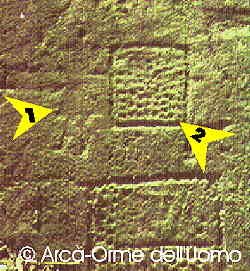
Aussois (F): a topographic figure (2) superimposes an Iron age warrior (1)
It appears obvious that there does not exist any relationship between this kind of topography and other engravings such as the famous “map” of Bedolina, placed by Anati in the last phase of the III style, i. e. at the Final Bronze (3), or topographic engravings at Aussois (France, see picture and Ballet-Raffaelli -4-). The stylistic differences are great: at Bedolina the geometric modules are square instead of rectangular, they are always contoured and never totally pecked and the alignments of dots are much more precise. In many cases there is then a central dot surrounded by a ring, and this convention is totally absent in the topographies of Vite and Dos dell’Arca. The topographic figures of Bedolina (and also some at Sellero -5-) in many cases are superimposed on men with weapons engraved in the first Iron Age, and appear to be subsequent to them. So they can be dated to the middle or final Iron Age.
Instead, regarding the second of the above points, the pre-Remedellian age (6) of the most ancient phase of the topographies is very clear. This is demonstrated (7) by the engraved menhirs of Bagnolo I, Ossimo 8 and Borno I, where filled rectangles with double base, macule and alignments of dots are subjected both to the Remedellian and “campaniformi” phases. The same “village-maps” of Vite present eyelets in the perimetric lines very similar to those of the Camunian and Valtellina chalcolithic stelae.
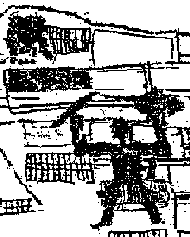
Vite, rock no. 13: an Iron Age warrior superimposes topographic figures
The chronology of the orants, presumed neolithic until now, and so placed at the base of the camunian cycle (to shift instead between the middle Bronze and the first Iron Age) is currently being revised (8). The necessity of such a revision is shown by Ms Ferrario when she demonstrates the lack of any underposition to the Remedellian phases and the similarity with the warriors of the Final Bronze. To these arguments one could add the repeated co-occurrence of figures of orants and Iron Age figures. Such recurrent co-occurrence makes impossible an interval of over 3000 years between the figures, which instead are more likely to be part of a contiguous series.
Once the orants are placed in the Middle-Final Bronze, the pre-Remedellian topographic engravings constitute the first phase of Camunian rock art and they fit in well in an interpretative picture tied to an agricultural-pastoral economy.
Such chronological and attributive implications must reflect themselves integrally in the analogous figures of Mt. Bego, elucidating some important clarifying factors. Henry de Lumley’s last great work (9) interprets the topographic engravings in the context of the geometric figures. The latter include the so-called grids, the compound geometric figures and the filled rectangles. The compound geometric figures occur almost uniquely in the Fontanalba sector. Both the grids and the compound geometric figures are interpreted by De Lumley, in accordance with Bicknell, in a topographic sense – in particular, as a “symbol” of the cultivated fields or the enclosures for animals, with the infilling by dots being interpreted as symbolizing the fertilizing rain.
De Lumley’s general interpretation of the engravings of Bego is based on the theory of the expression of the divine. This involves a religion of the Sacred Mountain which sees its central expression in the primordial divine couple of the God Sky (male) and of the Goddess Earth (female), symbolized respectively by the bull-thunderbolt-knife and by the cultivated enclosures-fields. In this context the topographic engravings appear to represent both the earth and female divinity at the same time (the Goddess Mother, the God Earth).
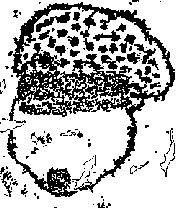
Vite, rock no. 3: this kind of figure is very similar to the topographic ones found at Fontanalba, Mt. Bego
De Lumley’s chronology, amplified recently, concentrates the Bego engravings in a Chalcolithic-Ancient Bronze time range (2500-1700 B. C.), hypothesizing a greater ancientness of the Fontanalba sector compared to those of the Meraviglie (end Chalcolithic-Ancient Bronze). In reality the compound geometric figures are identical to the pre-Remedellian topographies of Valcamonica. Archaeological excavations done at Bego (Gias del Ciari, Conti 1942) have shown a human presence starting from the cardial Ancient Neolithic up to the Chalcolithic and the Ancient Bronze.
So one can hypothesize also at Bego area a pre-Remedellian engraving phase (Final Neolithic or beginning of the Copper Age) before 2900 B. C. that, therefore, anticipates by a few centuries the beginning of the engraving practices at Mt. Bego.
Such a hypothesis is confirmed by several superimpositions present in zone XIX where both drawings of horned animals and knives with elongated triangular blade superimpose the rectangular topographic figures. Unfortunately, study of the superimpositions is not facilitated by examination of the tracings, which do not distinguish between underpositioned and superimposed figures.
Continued from (previous TRACCE issues):
To continue with (next TRACCE issues):
- Part 3 - Diffusion
- Part 4 - Interpretation
Pictures (from top):
- Aussois (F): a topographic figure (2) superimposes an Iron age warrior (1)
- Vite, rock no. 13: an Iron Age warrior superimposes topographic figures
- Vite, rock no. 3: this kind of figure is very similar to the topographic ones found at Fontanalba, Mt. Bego
CERVENO (Bs), Italy. tel. 39-364-433983 – fax 39-364-434351
BIBLIO (Arcà – topographic)
- FOSSATI A., 1994. Le rappresentazioni topografiche, in Le Pietre degli Dei. Menhir e statue stele dell’età del Rame in Valcamonica e Valtellina, a cura di S. Casini, Bergamo, pp. 89-91 and
ARCA’ A., 1995. Vite, incisioni topografiche: prima fase dell’arte rupestre camuna, Notizie Archeologiche Bergomensi 2 - SLUGA G., 1969. Le incisioni rupestri di Dos dell’Arca, edizioni del Centro, Capo di Ponte
- ANATI E., 1976. Evoluzione e stile nell’arte rupestre camuna, Edizioni del Centro, Capo di Ponte, p. 110
- BALLET F. , P. RAFFAELLI 1990. Rupestres. Roches en Savoie. Gravures, peintures, cupules, Chambery.
- SANSONI U. – GAVALDO S.., 1995. L’arte rupestre del Pià d’Ort – La vicenda di un santuario preistorico alpino, edizioni del Centro, Capo di Ponte
- for the remedellian and “Campaniforme” phases in sytle III of Valcamonica refer to: DE MARINIS R., 1994. La datazione dello stile IIIA, in Le pietre degli Dei. Menhir e stele dell’età del Rame in Valcamonica e Valtellina, Bergamo, p. 69-87
- ARCA’ A., 1992. La Roccia 13 di Vite, Paspardo: elementi per un archivio di archeologia rupestre, in “Appunti” 19, p. 25-31; FOSSATI 1994; ARCA’ 1995. Vite…
- FERRARIO C. 1992. Le figure di oranti schematici nell’arte rupestre della Valcamonica, in “Appunti” 19, p. 41-43 and FOSSATI A., 1992. Alcune rappresentazioni di “Oranti” schematici armati del Bronzo Finale nell’arte rupestre della Valcamonica, in “Appunti” 19, p. 44-50
- DE LUMLEY H., 1995. Le grandiose et le sacré, Edisud, Aix en Provence
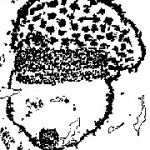
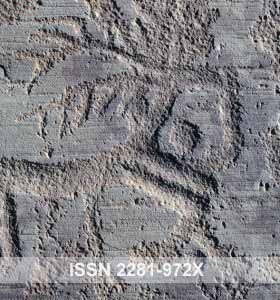













Leave a Reply